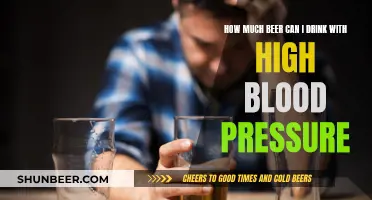
Drinking and driving is a dangerous combination. Even a single drink can cause driving impairments, and it can take over an hour for the alcohol from one beer to be processed in the bloodstream. While one beer will usually keep you below the legal limit, any amount of alcohol can impact your ability to drive safely. Alcohol impairs judgement, slows reaction time, makes it hard to focus, affects your ability to control the car or speed, reduces coordination, and inhibits your ability to track moving objects. The safest thing to do is to not get behind the wheel after drinking. If you plan on drinking, arrange a different way to get home, such as public transportation, a designated driver, or a rideshare.
| Characteristics | Values |
|---|---|
| Number of drinks to affect driving ability | 1 |
| Time to process one drink | 1 hour |
| Effects of one drink | Impaired judgement, lack of ability to make informed decisions, double vision, inability to accurately gauge depth perception, inability to distinguish colours |
| Effects of two drinks | Inability to multitask and track moving objects, difficulty steering or shifting, difficulty slowing down or stopping quickly |
| Legally drunk | 3-4 drinks |
| Effects of 3-4 drinks | Inability to judge speed or stay in lane, easily distracted, inability to tell how fast you are driving, loss of concentration |
| Effects of 5-6 drinks | Slowed information processing, difficulty steering, accelerating or braking |
| Effects of 6+ drinks | Inability to think, see or move well |
What You'll Learn
- One drink can take over an hour to be processed in the bloodstream
- Alcohol can cause double vision and affect depth perception
- A sober driver, or designated driver, is a safer option
- Gender, weight, genetics, and food intake can affect alcohol impairment
- In California, a DUI can be charged if a police officer believes driving ability is impaired

One drink can take over an hour to be processed in the bloodstream
Drinking and driving is never advisable, even if you've only consumed one alcoholic beverage. Alcohol affects your driving ability in several ways, including impaired judgement, slower reaction times, reduced coordination, and difficulty focusing on driving. These effects can be dangerous and lead to accidents.
It's important to note that alcohol affects everyone differently. Even if you feel sober, your driving skills may still be impaired. The only way to completely eliminate alcohol from your system is to give your liver time to break it down. There are no quick fixes or shortcuts to sober up faster. Consuming food or coffee may make you feel more alert, but they do not eliminate alcohol from your bloodstream.
To ensure safety, it is recommended to refrain from driving after consuming any amount of alcohol. Make alternative arrangements for transportation or allow sufficient time for the alcohol to clear your system before getting behind the wheel.
Drinking Non-Alcoholic Beer: Safe Driving or Legal Trouble?
You may want to see also

Alcohol can cause double vision and affect depth perception
Drinking and driving is a dangerous combination. Even a single drink can affect your vision and driving ability. Alcohol can cause blurred or double vision, affecting your depth perception and making it difficult to judge the distance to objects while driving. This can lead to collisions and accidents.
How Alcohol Affects the Body and Vision
When you drink alcohol, it affects your body and vision in various ways. Alcohol impairs your depth perception, making it difficult to accurately judge the distance to objects. This is due to the impact of alcohol on motion parallax, which is necessary for understanding how far away objects are relative to your vehicle. For example, when driving, trees in the distance will appear to pass by slower than grass on the side of the road. If you're unable to perceive this change in depth accurately, it can lead to accidents and collisions.
The "Beer Goggles" Effect
Alcohol also alters your perception of images, leading to the well-known "beer goggles" effect. People who have been drinking often rate images as more attractive. This effect is caused by diminished communication between the eyes and the brain.
Short-Term Effects of Alcohol on Vision
In addition to double vision, alcohol can cause blurred vision, dry eyes, and poor night vision. These effects can vary from person to person and are typically temporary, wearing off as the person sobers up. However, they can significantly impact your driving ability and make it dangerous to get behind the wheel.
Long-Term Effects of Alcohol on Vision
Long-term excessive drinking can have permanent negative consequences on your vision and overall eye health. It can lead to optic nerve damage, which can result in low vision or even blindness. Additionally, alcohol abuse can contribute to an increased risk of developing cataracts and age-related macular degeneration.
Factors Affecting Alcohol Metabolism
It's important to note that the number of drinks it takes to reach a certain blood alcohol level varies depending on factors such as sex, weight, body size, and what you ate. For example, a 100-pound woman may experience blurred vision after two drinks in an hour, while a 240-pound man may not show the same effects until up to five drinks in an hour. Therefore, it's crucial to consider these factors and understand your limits before deciding to drive after consuming alcohol.
Drinking Beer in Autzen Stadium: What's Allowed?
You may want to see also

A sober driver, or designated driver, is a safer option
Drinking and driving is a dangerous combination. Even a single drink can cause driving impairments, as alcohol affects your judgment, slows your reaction time, and makes it difficult to focus on driving. It impairs your ability to control the car, reduces coordination, and inhibits your ability to track moving objects.
The effects of alcohol begin immediately and can last for over an hour. A single alcoholic beverage can take over an hour to be processed in the bloodstream, meaning that even if you have a single drink half an hour before driving, there may still be alcohol in your system.
The amount of alcohol in a standard drink can vary, and factors such as body weight, biological sex, age, food consumption, and medications can affect how alcohol is metabolized. As a result, it is challenging to determine how alcohol will impact your driving ability, even if you only plan on having one drink.
To ensure safety, it is best to arrange alternative transportation if you plan on drinking. A sober driver, or designated driver, is a safer option than getting behind the wheel yourself after drinking. They can help you stay safe by ensuring that everyone in your group gets home safely without putting themselves or others at risk.
While it may be costly to use ridesharing or taxi services, these options are safer than driving after drinking. If cost is a concern, selecting a designated driver from your group is a more affordable alternative. This person should refrain from drinking and take responsibility for driving everyone home. By choosing a designated driver, you can avoid the risks associated with impaired driving and potential legal consequences.
In summary, if you plan to drink, the safest option is to arrange alternative transportation. A sober driver or designated driver can help ensure the safety of everyone in your group without risking the negative consequences of drinking and driving.
Lip Piercing and Beer: What You Need to Know
You may want to see also

Gender, weight, genetics, and food intake can affect alcohol impairment
Gender, weight, genetics, and food intake can all affect alcohol impairment. Here's how:
Gender
Women tend to become more impaired than men after drinking similar amounts of alcohol. This is because women tend to have a higher blood alcohol concentration (BAC) than men, even when the amount of alcohol consumed is adjusted for body weight. This may be due to differences in total body water content, as alcohol is dispersed in body water. Women also tend to eliminate more alcohol per unit of lean body mass per hour than men, leading to a higher alcohol disappearance rate. As a result, women may be more susceptible to alcohol-related cognitive impairments, such as short-term memory loss and delayed recall. However, psychomotor performance, such as eye-hand coordination and body sway, does not appear to be affected by gender.
Weight
Weight can influence alcohol impairment in a few ways. Firstly, individuals with a higher body weight may have a lower BAC than those with a lower body weight, as alcohol is dispersed in body water. Additionally, weight can impact how quickly alcohol is absorbed and eliminated from the body. A larger body size may result in slower absorption, leading to a lower peak BAC. On the other hand, a higher body weight may also result in a higher liver volume, which can increase the rate of alcohol metabolism and elimination.
Genetics
Genetics can also play a role in alcohol impairment. Variations in certain genes, such as alcohol dehydrogenase (ADH) and aldehyde dehydrogenase (ALDH) genes, can affect the rate at which alcohol is metabolized and eliminated from the body. For example, individuals with certain variants of the ALDH2 gene exhibit the "Asian flushing reaction," which includes facial flushing, tachycardia, and nausea after consuming small amounts of alcohol. This reaction deters most individuals from excessive drinking. Additionally, studies have shown that genes such as GABRA2 and CHRM2 may contribute to alcohol dependence and key endophenotypes.
Food Intake
Food intake can influence alcohol impairment in several ways. Firstly, eating before drinking can slow the rate at which alcohol reaches the small intestine, helping to taper absorption and prevent individuals from feeling too drunk too quickly. Consuming food with a mixture of protein, fat, and carbohydrates is recommended. Secondly, alcohol can increase hunger and food cravings by temporarily increasing serotonin levels and lowering inhibitions. This may lead to poor food choices and increased food intake. Finally, drinking water between alcoholic beverages is important to give the body time to process the alcohol and prevent dehydration, which can have serious health consequences.
Beer and Diabetics: Can One Drink Cause a Seizure?
You may want to see also

In California, a DUI can be charged if a police officer believes driving ability is impaired
Drinking and driving is a dangerous combination. Alcohol affects your judgment, slows your reaction time, and makes it difficult to focus on the road, among other things. Even a small amount of alcohol can impact your driving ability.
In California, the legal limit for blood alcohol concentration (BAC) is 0.08% for drivers over 21 years of age, and 0.01% for those under 21. However, it's important to note that even if your BAC is below the legal limit, you can still be charged with a DUI if a police officer believes your driving ability is impaired. This is because California's DUI laws are complex and give officers some discretion in determining impairment.
If you are pulled over and a police officer suspects you are driving under the influence, they will likely ask you a series of questions and may request that you perform a field sobriety test. These tests assess your balance, coordination, and ability to follow directions. While you have the right to refuse these tests, refusing may result in the officer using other evidence, such as your driving behavior or the smell of alcohol, to establish probable cause for an arrest.
If you are arrested for a DUI in California, your driver's license is automatically suspended, and you may face additional consequences such as hefty fines or even jail time. It is important to understand your rights during a DUI stop, including your right to remain silent, your right to refuse field sobriety tests, and your right to legal representation. Contacting a skilled DUI attorney as soon as possible can help protect your rights and guide you through the legal process.
Remember, the safest option is to avoid drinking and driving altogether. If you plan to consume alcohol, make alternative arrangements for transportation or wait until your body has had enough time to process the alcohol.
Beer and Eliquis: Safe Mix or Health Risk?
You may want to see also
Frequently asked questions
No, it is not okay to drink even one beer and then drive. Alcohol starts impacting your driving ability sooner than you might realize, and you may feel sober when you're not. Your ability to judge and coordinate could be impaired, and you may have difficulty seeing cars or people.
Drinking one beer will affect your ability to multitask and track moving objects. You may have difficulty driving if you are also trying to follow directions from your GPS or hold a conversation with a passenger. You may also have a harder time noticing other vehicles or pedestrians around you.
If you plan on drinking, do not drive yourself home. Make other arrangements for a ride home before drinking, such as public transportation, a designated driver, or a rideshare/taxi service.







